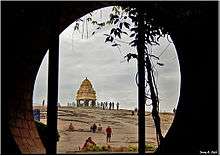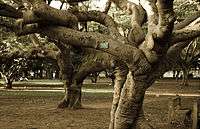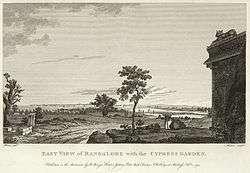Lal Bagh
| Lalbagh | |
|---|---|
| Botanical Garden | |
|
The Lalbagh Glass House in the Botanical Garden | |
 Lalbagh Location in Bengaluru, India | |
| Coordinates: 12°57′N 77°35′E / 12.95°N 77.59°ECoordinates: 12°57′N 77°35′E / 12.95°N 77.59°E | |
| Country | India |
| State | Karnataka |
| District | Bangalore Urban |
| Metro | Bengaluru |
| Languages | |
| • Official | Kannada |
| Time zone | IST (UTC+5:30) |
Lalbagh or Lalbagh Botanical Gardens, meaning The Red Garden in English, is a well known botanical garden in southern Bangalore, India. The garden was originally commissioned by Hyder Ali, the ruler of Mysore, and later finished by his son Tipu Sultan.[1] It has a famous glass house which hosts two annual flower shows (January 26th & August 15th). Lalbagh houses India's largest collection of tropical plants, has a lake, and is one of the main tourist attractions in Bangalore.[2] Lal Bagh is also home to a few species of birds. The commonly sighted birds include Myna, parakeets, crows, Brahmini Kite, Pond Heron, Common Egret, Purple Moor Hen etc.
History

_The_Lall_Bagh_or_Red_Garden_1860.jpg)
Hyder Ali commissioned the building of this garden in 1760 but his son, Tipu Sultan, completed it. Hyder Ali decided to create this garden on the lines of the Mughal Gardens that were gaining popularity during his time. Hyder Ali laid out these famous botanical gardens and his son added horticultural wealth to them by importing trees and plants from several countries. Hyder Ali deployed people from Thigala community who were extremely good in gardening.[3] The Lalbagh gardens were commissioned by the 18th century and over the years it acquired India's first lawn-clock and the subcontinent's largest collection of rare plants. [4]
The Lalbagh gardens are based on the design of the Mughal Gardens that once stood at Sira, at a distance of 120 km from Bengaluru on the main NH4 at Tumkur District in Karnataka. This is amply supported by ASI (Archaeological Survey of India) and other historical records. At that time, Sira was the headquarters of the strategically important southernmost Mughal "suba" (province) of the Deccan before the British Raj.[5]
In 1874, Lalbagh had an area of 45 acres (180,000 m2). In 1889, 30 acres were added to the eastern side, followed by 13 acres in 1891 including the rock with Kempegowda tower and 94 acres more in 1894 on the eastern side just below the rock bringing it to a total of 188 acres (760,000 m2).[6] The foundation stone for the Glass House, modelled on London's Crystal Palace was laid on 30 November 1898 by Prince Albert Victor and was built by John Cameron, the then superintendent of Lalbagh.[6][7]
Overview
Lalbagh is a 240 acres (0.97 km2) garden and is located in south Bangalore. It holds a number of flower shows, especially on the Republic Day (26 January). The garden has over 1,000 species of flora. The garden also has trees that are over 100 years old.[2][8]
The garden surrounds one of the towers erected by the founder of Bangalore, Kempe Gowda. The park has some rare species of plants brought from Persia, Afghanistan and France. With an intricate watering system for irrigation, this garden is aesthetically designed, with lawns, flowerbeds, lotus pools and fountains. Most of the centuries-old trees are labelled for easy identification. The Lalbagh Rock, one of the oldest rock formations on earth, dating back to 3,000 million years, is another attraction that attracts the crowds.[2]
Gates
Lalbagh has four gates. The western gate is situated near Siddapur Circle and One can enter this gate and enjoy the silvan atmosphere of the garden. Outside, touching the compound gate, is Krumbigal Road. The other side of the road touches the compound wall of R.V.School. The National College, Rashtraya Vidyalaya, Chikkamavalli and Doddamavalli are nearby. The other side of the road goes to 'Krishna Rao road', where you can see The Indian Institute of World Culture, a beautiful library and a fine auditorium, which hosts a programme every week. Farther south, Model House street and the Yediyur Terminus are the main points.
The eastern gate has a wide road with Jayanagar close by. The southern gate is often referred to as the main gate and is near Lalbagh Road. The northern gate is a fairly wide and big road leading to the Glass House and serves as the primary exit.
Tourism and eco-development
Lalbagh remains open daily from 6:00 a.m. to 7:00 p.m. throughout the year. For the benefit of joggers, tourists and fitness enthusiasts, entry is free from 6:00 a.m. to 9:00 a.m. and from 6:00 p.m. to 7:00 p.m. At other times, a fee of Rs.10/- is charged. Entry for school children and the disabled is free all day.[2]
Flower shows are conducted every year during the week of Republic day and Independence day, to educate people about the variety of flora and develop public interest in plant conservation and cultivation.[9] Entry fee for adults is Rs. 40/- (On weekends and Public holidays - Rs. 50/-) and for children below 12 years, Rs. 10/-.
The government of Karnataka organizes "Janapada Jaatre" in Lalbagh [10] on the second and fourth weekends (both Saturday and Sunday) of every month. Janapada Jaatre, which translates to Folk Fair, features folk dance, music and plays performed by troupes from all parts of Karnataka. The show mainly depicts the cultural folklore of Karnataka, the traditional costumes and musical instruments.[2]
A geological monument for the peninsular gneiss formation is also a tourist attraction at the gardens. This monument has been designated by the Geological Survey of India on the Lalbagh hill which is made up of 3,000 million-year-old peninsular gneissic rocks. One of the four cardinal towers erected by Kempegowda II, also a major tourist attraction, is seen above this hillock. This tower gives the full view of Bangalore from the top.[11][12]
Save Lalbagh protests
As part of the ongoing development of the Bangalore metro rail, the Bangalore Metro Rail Corporation Ltd has acquired a section of Lal Bagh of around 1,135 m2 where tree felling is taking place. On April 13 and 14, 2009, 500 feet of Lalbagh's wall was broken down and a number of eucalyptus trees were cut.
Citizens protests started almost immediately and have been continuing on a weekly basis. Protests are being made against illegal tree felling and land acquisition by the government without paying heed to various acts put into place to protect Bangalore's greenery and public park spaces.
Connectivity
Lalbagh is well connected by Bangalore Metropolitan Transport Corporation buses from Kempegowda Bus Station/Shivaji Nagar. All buses towards Jayanagar/Banashankari areas pass through one of the four gates of Lalbagh.
Gallery
- Lalbagh Gallery
-

Panoramic view of the Kempegowda tower
-

A beautiful side view of Glass House
-
Interior view of the Glass house at Lalbagh Botanical Gardens
-
Largest known Kapok specimen, located in Lalbagh
-

Evening View of the Lake inside Lalbagh
-
A Japanese decorative monument found in Lalbagh
-

A very old tree from Lalbagh Bangalore
-
Lalbagh Lake
-
-
-
A statue of Sri ChamRajendra Odeyar, ex ruler of Mysore at Lalbagh
-
A Japanese decorative monument found in Lalbagh
-
Lalbagh Botanical Garden - Annual Mango Festival
-
Lalbagh Famous Tree Fossil
References
- ↑ "Bangalore Tourist Attractions".
- 1 2 3 4 5 "Department of Horticulture, Bangalore". Retrieved August 20, 2015.
- ↑ People of India - Kumar Suresh Singh, Anthropological Survey of India - Google Books
- ↑ "History of Lalbagh Botanical Garden". Retrieved August 20, 2015.
- ↑ Benjamin Rice, Lewis (1897). Mysore: A Gazetteer Compiled for the Government, Volume I, Mysore In General, 1897a. Westminster: Archibald Constable and Company. p. 834.
- 1 2 "A jewel in Lalbagh’s crown". Deccan Herald. Retrieved 23 November 2010.
- ↑ Suresh Singh, Kumar. People of India: Karnataka Vol. xxvi. Affiliated East-West Press (Pvt.) Ltd. ISBN 978-8-1859-3898-1.
- ↑ Bowe, Patrick (2002) Charles Maries: Garden Superintendent to Two Indian Maharajas. Garden History 30(1):84-94
- ↑ "Lal Bagh Flower Show 2008 Ticket Booking". Retrieved 2009-03-01.
- ↑ "Lalbagh Botanical Garden Info".
- ↑ "Peninsular Gneiss". Geological Survey of India. Retrieved 2009-02-27.
- ↑ National Geological Monuments, pages 96, Peninsular Gneiss,page29-32. Geological Survey of India,27, Jawaharlal Nehru Road, Kolkatta-700016. 2001. ISSN 0254-0436.
External links
| Wikimedia Commons has media related to Lal Bagh Botanical Garden. |
| ||||||||||||||||||||||||||||||||||||||
| ||||||||||||||||||

